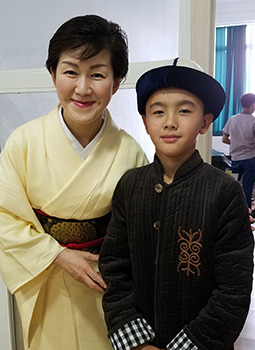INDEX

Rokyoku artist Tamagawa Nanafuku 
Performing in Tashkent, the capital of Uzbekistan 
Cultural exchange with an 11-year-old Manas (Kyrgyz epic poem) performer in Kyrgyzstan
- PREVIOUS
- NEXT
January 2022
Bringing the Japanese Storytelling Art of Rokyoku to the World

Tamagawa Nanafuku, a rokyoku artist, toured seven countries in Europe and Central Asia from May to July 2018 as a Japan Cultural Envoy. Nanafuku told us about that experience.

Rokyoku is a type of narrative singing. A rokyoku artist tells a variety of stories in distinctive fushi (verses) and tanka (literally, caustic remark) lines accompanied by the shamisen, a traditional Japanese musical instrument. Rokyoku originated in the early Meiji period (1868–1912) and was once one of the most popular performing arts in Japan. Its popularity gradually declined, however, with the number of rokyoku artists dwindling from 3,000 during its heyday to a mere 80 today.
When first appointed as a Japan Cultural Envoy, Tamagawa Nanafuku thought that rokyoku was an art in danger of extinction and therefore needed to be made more popular in Japan before taking it to audiences overseas. However, a growing desire to find out whether rokyoku would be understood outside of Japan led her to accept the role, touring seven countries from May to July 2018: Italy, Slovenia, Austria, Hungary, Poland, Kyrgyzstan and Uzbekistan.

Rokyoku stories include themes such as giri (social obligation) and ninjo (human feeling), love and friendship, and historical events, bringing laughter and tears to the audience. If the audience does not understand the language, they will not be able to follow the show’s story and will be left behind. Nanafuku prepared subtitles and took care to ensure they were well timed. Nevertheless, she feared that the stories would not resonate with audiences that were unfamiliar with traditional Japanese manners and customs, and that in countries with different values, the meaning of the stories themselves would not be understood. However, that fear turned out to be unfounded.
As a Japan Cultural Envoy, Nanafuku chose the classic Sendai no Oni Fufu as one of her pieces to perform overseas. The story tells of a wife’s shrewd plan to retrain her useless husband in swordsmanship and restore him to his former glory, and the scene in which she coaches him back into shape was met with enthusiastic applause from the audience. “Particularly in Italy, Slovenia, Hungary and Poland, where the employment rate of women is high, women enjoy a high status in the family, so they called out ‘Bravo!’,” says Nanafuku. In Islamic countries such as Kyrgyzstan and Uzbekistan, she had heard that women’s status was less established so thought this piece would not be understood. However, it seems that people in those countries also enjoyed it. Nanafuku learned firsthand that while religions, customs and values may differ, stories with familiar contents that depict the range of human feelings, such as the discord between husband and wife, parents and children, or daughter-in-law and mother-in-law, and the struggle between selfishness and giri (social obligation) and ninjo (human feeling), and whether to be just or turn to evil, strike a chord with audiences around the world.


“Another well-known Japanese storytelling art form, rakugo, developed in the urban areas of Edo (Tokyo) and Osaka, so it is witty and sophisticated. I feel that rokyoku, on the other hand, has more of the boundless primordial energy of human beings. Its pleasure comes from the fundamental human emotions: a fierce full range of feeling, such as wailing and loud laughter. Another example of that raw energy is the improvisational nature of the interaction between the rokyoku artist and the shamisen accompanist. There’s no musical score, so the to-and-fro between the rokyoku artist and the shamisen accompanist feels exciting,” says Nanafuku.
Although she initially thought going abroad was out of the question, once she got there Nanafuku noticed something she couldn’t have in Japan. She found that the audience’s understanding of Japanese manners and customs was due to the fact that many of them had seen movies directed by Kurosawa Akira. This made her appreciate how much the cultural exchanges of today are built upon the foundation of the great cultural works of the pioneers. Having returned to Japan and with a broader outlook of wanting to promote rokyoku around the world, Nanafuku now devotes every day to preparing for her next opportunity to perform overseas.
- PREVIOUS
- NEXT

